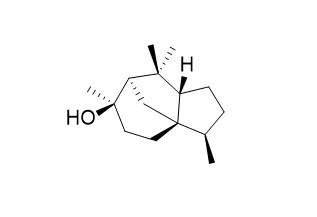| Kinase Assay: |
| J Toxicol Environ Health A, 2014, 77(22-24):1522-1532. | | Inhibitory effects of cedrol, β-cedrene, and thujopsene on cytochrome P450 enzyme activities in human liver microsomes.[Reference: WebLink] | Cedrol, β-cedrene, and thujopsene are bioactive sesquiterpenes found in cedar essential oil and exert antiseptic, anti-inflammatory, antispasmodic, tonic, astringent, diuretic, sedative, insecticidal, and antifungal activities. These compounds are used globally in traditional medicine and cosmetics.
METHODS AND RESULTS:
The aim of this study was to investigate the inhibitory effects of Cedrol, β-cedrene, and thujopsene on the activities of eight major human cytochrome P-450 (CYP) enzymes using human liver microsomes to assess potential β-cedrene-, Cedrol-, and thujopsene-drug interactions. Cedrol, β-cedrene, and thujopsene were found to be potent competitive inhibitors of CYP2B6-mediated bupropion hydroxylase with inhibition constant (Ki) values of 0.9, 1.6, and 0.8 μM, respectively, comparable with that of a selective CYP2B6 inhibitor, thioTEPA (Ki, 2.9 μM). Cedrol also markedly inhibited CYP3A4-mediated midazolam hydroxylation with a Ki value of 3.4 μM, whereas β-cedrene and thujopsene moderately blocked CYP3A4. Cedrol, β-cedrene, and thujopsene at 100 μM negligibly inhibited CYP1A2, CYP2A6, and CYP2D6 activities. Only thujopsene was found to be a mechanism-based inhibitor of CYP2C8, CYP2C9, and CYP2C19. Cedrol and thujopsene weakly inhibited CYP2C8, CYP2C9, and CYP2C19 activities, but β-cedrene did not.
CONCLUSIONS:
These in vitro results indicate that Cedrol, β-cedrene, and thujopsene need to be examined for potential pharmacokinetic drug interactions in vivo due to their potent inhibition of CYP2B6 and CYP3A4. |
|
| Animal Research: |
| Planta Medica, 2003, 69(7):637--641. | | The sedative effects and mechanism of action of cedrol inhalation with behavioral pharmacological evaluation.[Reference: WebLink] | It has been reported that cedarwood oil has sedative effects when inhaled. In this study, we evaluated sedative effects of inhaled Cedrol, which is a major component of cedarwood oil.
METHODS AND RESULTS:
Accumulative spontaneous motor activity was significantly decreased in the Cedrol-exposed Wistar rats. Similar results were confirmed in caffeine-treated Wistar rats, spontaneously hypertensive rats (SHR), and ddY mice. In addition, exposure to Cedrol prolonged pentobarbital-induced sleeping time in Wistar rats. To investigate whether Cedrol, which has a very faint aroma, affects the olfactory system, the nasal cavities of Wistar rats were treated with zinc sulfate to reduce olfactory function. Two days later, the pentobarbital-induced sleep time was measured as described above. Compared to intact rats, the sleep prolongation effect was decreased in a lavender-roman chamomile mixed oil exposure positive control group, indicating that olfactory function was impaired. In contrast, prolongation of the sleeping time did not change in the Cedrol exposure group.
CONCLUSIONS:
The above findings indicate that Cedrol inhalation had marked sedative effects regardless of the animal species or the functional state of the autonomic nerves, suggesting that the mechanism of action is via a pathway other than the olfactory system. | | Environmental Entomology,2014,43(3):762–766. | | Bioactivity of Cedarwood Oil and Cedrol Against Arthropod Pests.[Reference: WebLink] |
METHODS AND RESULTS:
Heartwood samples from Juniperus virginiana L. were extracted with liquid carbon dioxide, and the bioactivity of carbon dioxide-derived cedarwood oil (CWO) toward several species of ants and Cedrol toward ticks was determined. Repellency was tested for ants, and toxicity was tested for ticks. Ants in an outdoor bioassay were significantly repelled by the presence of CWO on a pole leading to a sugar-water solution. Similarly, CWO was a significant repellent barrier to red imported fire ants and prevented them from finding a typical food source. Black-legged tick nymphs exhibited dosage-dependent mortality when exposed to Cedrol and at the highest dosage (i.e., 6.3 mg/ml) tested, the Cedrol killed 100% of the ticks.
CONCLUSIONS:
These repellency and toxicity results together demonstrate a clear potential for the use of CWO as a pest control agent. | | Biomedicine & Pharmacotherapy, 2016, 83:641-647. | | Hair growth promoting activity of cedrol isolated from the leaves of Platycladus orientalis.[Reference: WebLink] | Platycladus orientalis (L.) Franco is traditionally known to potentiate hair growth promotion. However, there has been no report on its main active ingredient responsible for the hair growth activity.
METHODS AND RESULTS:
In the current work, Cedrol as a major constituent from P. orientalis was evaluated for its potential on hair growth in vivo. Different concentrations of Cedrol (10, 20 and 30mg/mL) were applied topically over the shaved skin of C57BL/6 mice and monitored for 21days. Results indicated that Cedrol significantly promoted hair growth in a dose-dependent manner, particularly for the female mice. Both male and female mice groups treated with 30mg/mL Cedrol required shorter time than the blank control and 2% minoxidil groups at different growth stages. Compared with the blank control (8.87mm) and 2% minoxidil (9.94mm) groups at 21days, the hair length of female mice treated with 30mg/mL Cedrol showed a remarkable increase with the value of 11.07mm. Hair in male and female mice groups treated with 30mg/mL Cedrol was heavier than the 2% minoxidil (38.2 and 35.9mg, respectively) groups with the weight of 42.6 and 45.2mg, respectively. Further observation of the hair follicle demonstrated that Cedrol exerted a remarkable effect on the hair follicle length.
CONCLUSIONS:
These findings suggested that Cedrol may be the main active ingredient of P. orientalis and have the potential of becoming a new hair growth promoter. |
|






 Cell. 2018 Jan 11;172(1-2):249-261.e12. doi: 10.1016/j.cell.2017.12.019.IF=36.216(2019)
Cell. 2018 Jan 11;172(1-2):249-261.e12. doi: 10.1016/j.cell.2017.12.019.IF=36.216(2019) Cell Metab. 2020 Mar 3;31(3):534-548.e5. doi: 10.1016/j.cmet.2020.01.002.IF=22.415(2019)
Cell Metab. 2020 Mar 3;31(3):534-548.e5. doi: 10.1016/j.cmet.2020.01.002.IF=22.415(2019) Mol Cell. 2017 Nov 16;68(4):673-685.e6. doi: 10.1016/j.molcel.2017.10.022.IF=14.548(2019)
Mol Cell. 2017 Nov 16;68(4):673-685.e6. doi: 10.1016/j.molcel.2017.10.022.IF=14.548(2019)